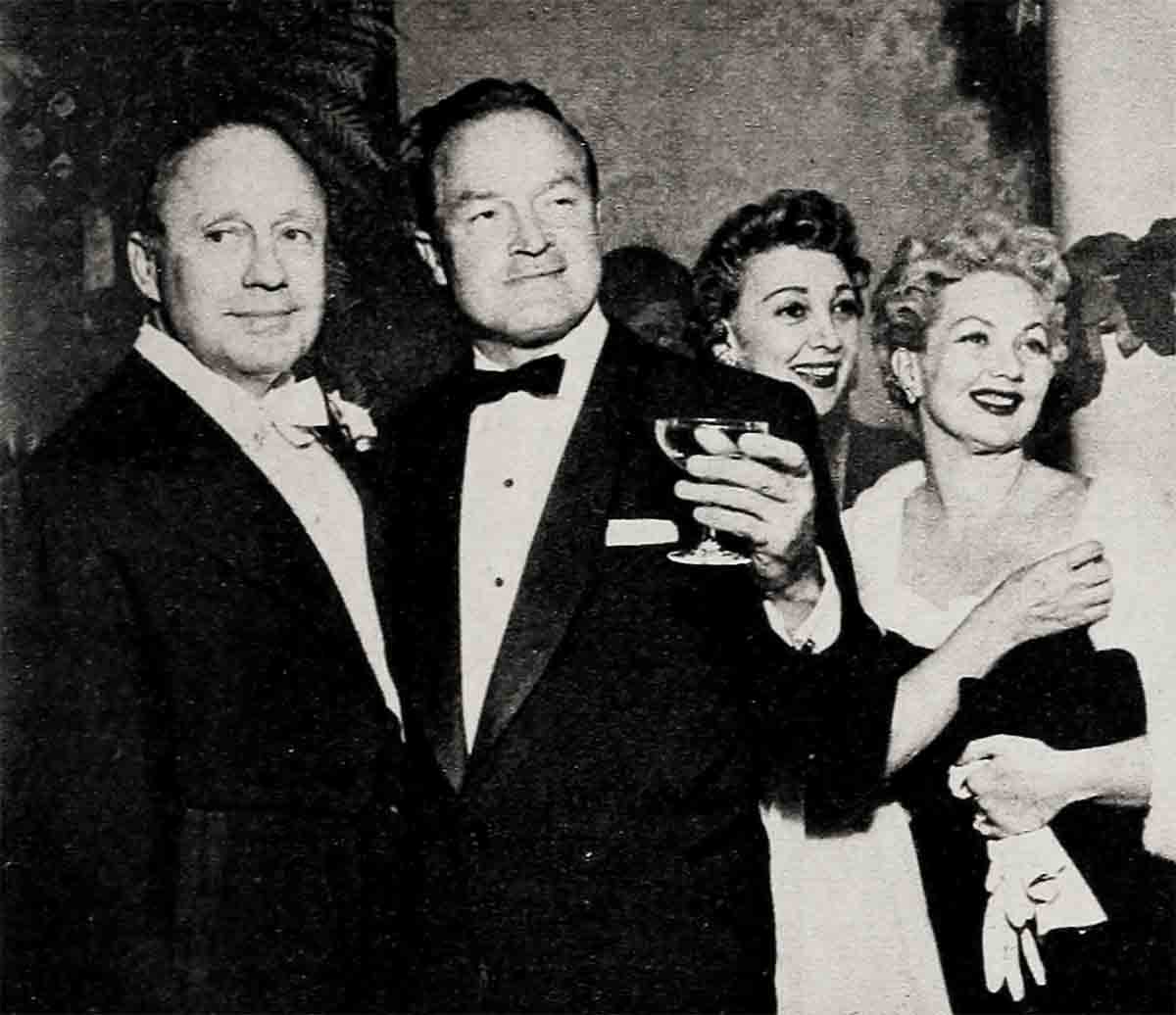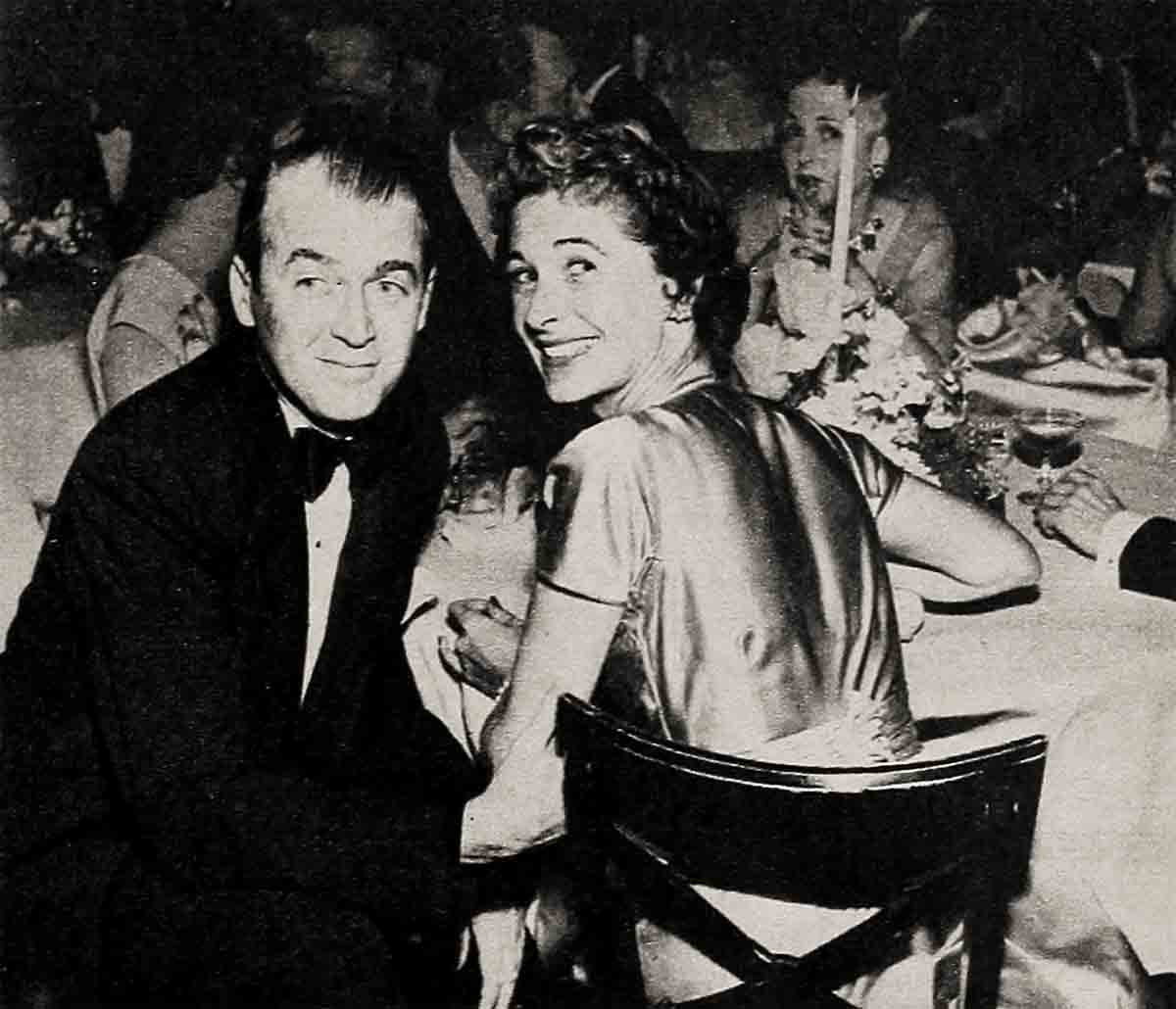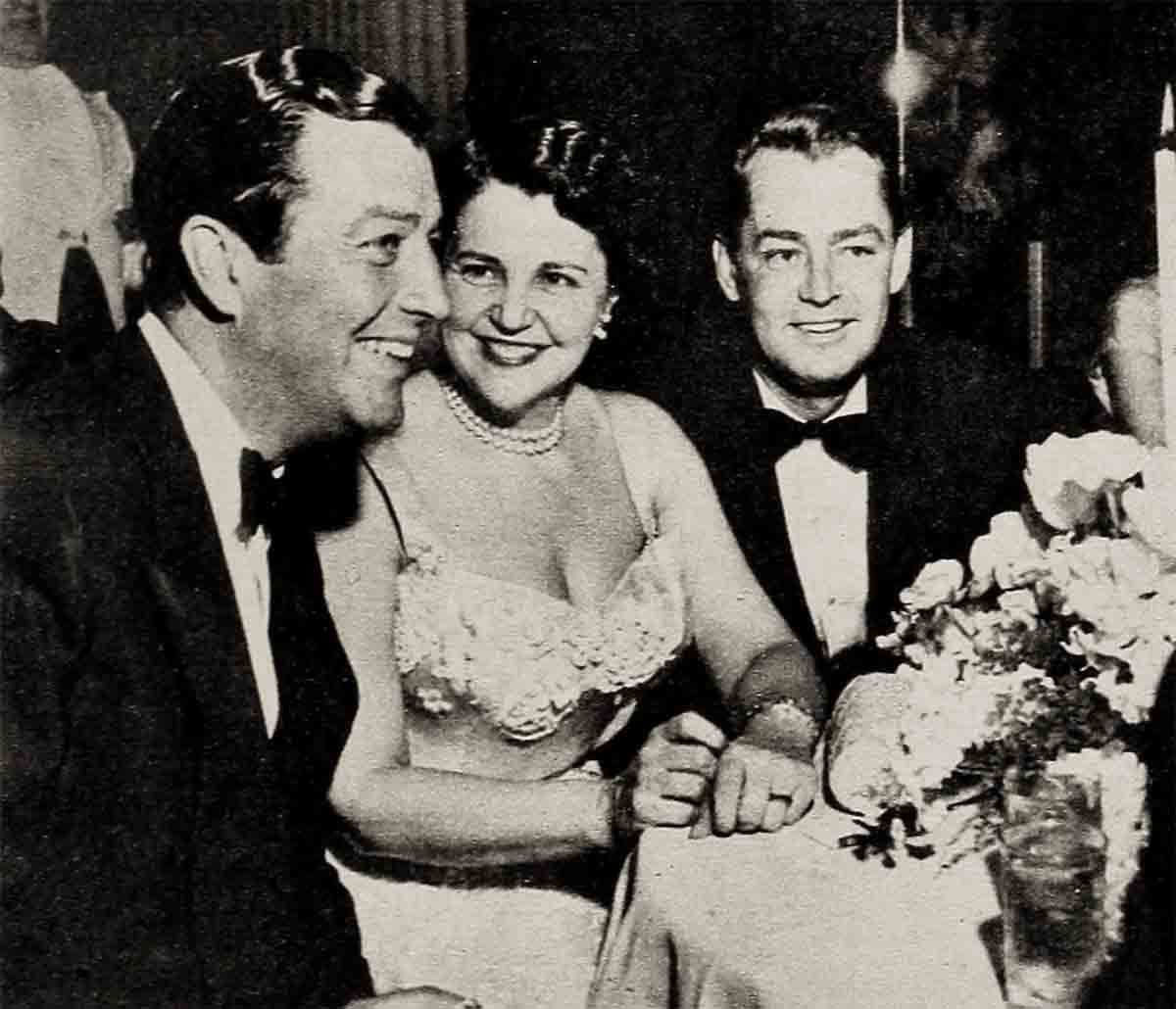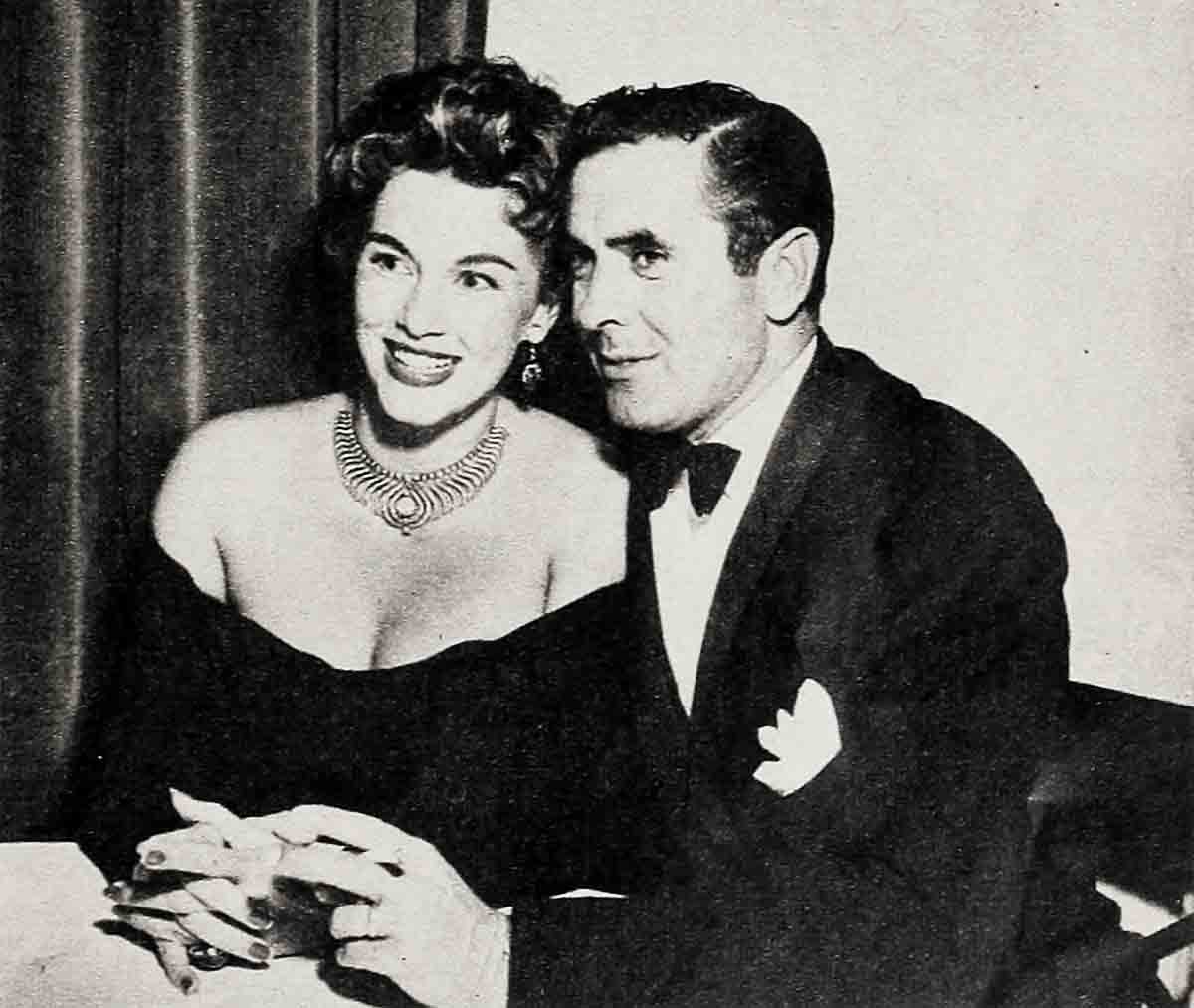
Who’s Got The Money?
It’s been nearly a. decade since Hollywood has seen a wedding as lavish as the Joan Benny-Seth Baker ceremony and reception last March 9. It cost Mary Livingstone and Jack Benny about $50,000 to marry off their adopted daughter. The wedding dress required a trip to Paris by designer Don Loper—to supervise the handweaving of the white satin brocaded in a lily of the valley pattern. It took thirty-five yards of it to make the skirt and seventeen more for the train. It took $2500, in fact, to buy this wedding dress.
Other expenses: 200-pound wedding cake, vintage champagne (1945) for 600 guests, five buffet tables loaded with delicacies, the Crystal Room of the Beverly Hills Hotel. white lilacs flown from Holland to California, and the services of twelve uniformed policemen and four plainclothesmen for protecting the jewelry of the guests.
All very fancy, but not outlandish for the beloved only daughter of a famous show business couple. Certainly, the Bennys don’t feel that they’ve spent an excessive amount. But there’s been nothing like it since Shirley Temple married John Agar.
The reason for that is not far to seek. Who, in Hollywood, has enough money to toss off such a party? The stars? Well, a few of them, for sure. Jack Benny, to dispense with his professional formula for a moment, is a generous man, but loaded, nonetheless. Benny, indeed, may have a few of Hollywood’s scattered millions.
Who is the richest star in Hollywood? Nobody outside the inner sanctum of the Department of Internal Revenue really knows, but according to the Sunset Strip grapevine, it may very well be Jimmy Stewart. During the past few years, Stewart has been leading the way in a new kind of jackpot: sharing his picture’s profits. Instead of getting a salary on his current films, Stewart is part owner of the picture and conservative estimates of his earnings on The Glenn Miller Story alone say three quarters of a million. Tyrone Power, John Wayne, currently Burt Lancaster and others have capitalized on this star-owner plan. Others have not been so shrewd. The $5,000-dollar-a-week salaries you read about really don’t go so far.
For instance, a few months ago, two famed and high-salaried figures in the entertainment world barricaded themselves in a New York hotel room rather than accept a subpoena that threatened surgery on their wallet.
The husband, Dick Haymes, was reputed to get $5000 a week for his theatre services, yet for some time he had been making plaintive noises indicating he couldn’t scrape up five bucks he could rightfully call his own.
The wife, Rita Hayworth Haymes, is rewarded by something in the neighborhood of $250,000 a picture. $250,000 is a quarter of a million dollars. Now it seemed to be touch and go between room service and starvation.
At about the same time, back in Hollywood, an actor who raked together $250,000 all told in 1953 was faced with a tax bite of $196,000. That was not extraordinary. He could and did pay it. That was extraordinary. He was one of two stars of a certain business management’s whole stable of Hollywood clients who was able to get up the scratch for Uncle Sam. Nor did this constitute a reflection on the business office’s acumen. On the contrary, it is one of the shrewdest in town.
Meanwhile, a fourth luminary, whose weekly salary is roughly $1500 more than the average American family is paid in a year, was turning up at various Hollywood gatherings in a series of brand new Cadillacs. The answer was not extravagance. The performer had bought each car on credit, had been unable to meet subsequent payments, had it repossessed, then bounded off to get another one—on credit.
Joan Benny’s lavish wedding symbolized the immense wealth Jack’s careful saving, wise investment have produced.

Now what the bemused public presumably would like to know is: Why can’t these gilded cuties with the staggering incomes keep themselves in the black? How is it that a guy with a take-home pay of less than $100 a week can keep himself and his loved ones solvent—if barely so—and another guy who gets $200,000 a year is only a jump ahead of the sheriff or is running neck and neck with him?
Well, MODERN SCREEN was curious about it, too, and presents a few of its findings.
But first, let it be clear that MODERN SCREEN does not consider itself an apologist for the poor screen star. The element of pathos in the economic collapse of the $5000-a-week hero is not much stronger than it would be if the Aga Khan absentmindedly took a Turkish bath on the day before his Moslem followers gave him his weight in platinum. The star has a pretty posh set-up however you look at it, and should be able to hang onto noodle money after the locusts have passed over.
But there is something of a case for the boys and girls. It will not and should not reduce you to a sympathetic crying jag, but it does negate in part the careless charges of spendthrift and addlepate.
There are a few of those still around, of course; the yacht-and-triple-alimony set is not wholly obsolete, and now and again, some lovely makes the journals by the rough equivalent of buying her favorite steed a chinchilla horse blanket. But all in all, these are, like the dinosaur, extinct, and the money troubles of most stars today are something like yours, if not much.
To begin with, let us take the actor who does indeed make in film salary $200,000 a year—under the usual contract, $5000 on a forty-week hitch. Salaries have dropped in the last years as taxes have risen, but there is a fair number of his kind left. If he makes this much money, he’s been around for quite a spell—ten years is a reasonable norm—probably has a family, and has outgrown the yen to rub champagne in his hair and regard a 1954 Jaguar as a suitable runabout for the gardener.

Let us take him and then let us take his check, before someone else does.
In the first place, a salary check for $5000 is no such thing. It starts its abortive life as a salary check for about $3900, since our star must pay withholding tax, of course.
Then—pow! his business manager (and if a star doesn’t have a canny, reputable business manager along the lines of Hollywood’s Bo Roos or Myrt Blum or Roger Graham, he is just asking for it) immediately pops $2500 more into the star’s tax account. This is the account the star stacks, like a squirrel, against the Ides of March, der tag! And this star, with his 200 grand, is in the ninety per cent bracket.
Very well. Mr. Got-Rocks now has $1400 of his flying start and more is yet to go.
To his agent goes $500, the customary ten per cent; to his business manager, a relatively modest $150, or three per cent; and to his insurance folk $100. Six-fifty left.
And fifty of that—zowie!—into the fund for the Motion Picture Home, and don’t think that’s not insurance. The Motion Picture Home is where he stands a good chance of winding up if he doesn’t manage his affairs like a neurotic hamster, a small rodent that hoards everything against a rainy day. The Motion Picture Home is the final refuge for the improvident great, near-great and never-great. It is the film industry’s looking after its own. It is at once pathetic, shocking and admirable—the names of some of its inhabitants would amaze you. But it must be maintained.

Fifty more dollars go to the mortgage. Stars are a mortgage-ridden lot. Those with fat contracts are prone to have much more credit than cash. So this one, say, has a $90,000 home with a $25,000 mortgage—and that makes him exceptionally solid.
What’s he left with now? $550? Still big money, eh? Enough to keep the wolf away from your door! Sure it is. But look again.
He hasn’t even started on his grocery bill, his utilities, his maintenance, his wardrobe, his wife’s wardrobe, his “children’s education, his car’s upkeep (maybe two cars, maybe three), his community taxes, his state taxes, and his rather fancy surplus overhead. For like it or not, a star foes supposed to live in a tree or wear jones. and the same goes for his loved ones. Furthermore, he should entertain now and then for business as well as social reasons. And that doesn’t mean milkshakes and salt water taffy all around.
A close professional audit of this final $550—and this essay is based not on guess-work but on highly expert conjecture—indicates that our star is still solvent if he doesn’t mind going without shoes.
And bear in mind that we are dealing with a fellow with no alimony trials (e.g. Dick Haymes, Errol Flynn, Dean Martin, Frank Sinatra), no tax delinquency tribulations (almost anyone you care to mention) and no lawsuits pending (Marlon Brando) nor suspension of his pay (Marilyn Monroe).
At this point, you could hardly be blamed for snorting into your cambric tea. Evidently we have here a man who is working for nothing or less than nothing, who is skidding toward catastrophe on the sweat of his brow, and who might be better off employed for wages in a garage or simply shooting himself.

Well, not quite. There are outs. That’s where the business consultant comes in. To over-simplify somewhat, our man can earn it, but he can’t keep it. But that’s impossible you say. Yes, of course, it’s impossible. But here is the happiest conception of his balance sheet, according to one of the most illustrious business brains in Hollywood:
Say a star earns $500,000 a year—an almost unheard of sum. He can keep $50,000 of it. But the conditions are that he live in a hall room, subsist on graham crackers and water, go nowhere and see no one, and draw on hypothetical savings.
That is not an extreme statement of the matter. That’s a fact. Now look once more at the financial statement of the star we have just left. To the extent that he’s solvent—“liquid” is the preferred trade term—he’s pretty well-heeled. But you saw how far we peeled him down simply by outgo for necessities. We left him no more than $550 at the top for what business managers call “personal living expenses”—and employed the term loosely.
Yet, one of the shrewdest of these men has appraised the personal living expenses of such relatively affluent stars as Joan Crawford, Jane Wyman and Dick and June Allyson Powell as running from $36,000 to $60,000 a year. Our “Star X” has been stranded with only $27,500. Minus shoes.
So here, by deposition of men best situated to know, is what he does.
First, he cuts a few corners. Domestic champagne will do as well as imported, or maybe the guests would settle for aspirin and Coke. His luxury car he may keep because it gives him the reassurance stars need so badly, but he drives it two years instead of one. (Two years, the management offices say, is the ideal economic life for a car anyway. No more, no less.) European and other trips, unless deductible or for sound business reasons, can be relegated to the category of fiddlefaddle. Last year’s mink will have to do for Mrs. X. Trifling, but a beginning.

Our beleaguered financial invalid now has to take a positive forward step. That means what the hotshots call “risk capital.” He’s got a contract and an assured income, and hence credit. On this credit, he borrows money, always under the close supervisory eye of his business brain. With this money, he buys, for example, into income property—pronounced in Hollywood “inkum poppity.” Inkum poppity can be a hotel or a motel or an apartment house. Fred MacMurray, whose nest is supposed to be spectacularly well-lined for an actor’s, is up to his hair-line in inkum poppity. The idea for Actor X is that he picks up a $75,000 poppity for a down payment only a fraction of that amount, then sits back and lets the money roll in. Or if it doesn’t exactly roll in, appreciation of values is working for him.
Alternatively, he can try for a capital gains set-up or a corporative deal or, if he’ll accept the advice of one wizard, buy into purebred livestock, said by this man to be a very good thing in 1954. Real estate’s not bad, nor oil wells if there’s oil in them. But he must invest risk capital and remember that high salaries, as a means of net gain, are as quaint today as the dodo.
“No star,” said a well-known business consultant recently, “who has come up since 1940 will make a million dollars from pictures. Very few will get ‘rich,’ a word I’m using to mean 200,000 clear dollars or more. Those days are over. You don’t have to feel sorry for the star but you don’t have to envy him either.”
And in spades, you do not have to envy Star X’s opposite number, the immortal champion of it’s-only-money and there’s-plenty-more-where-that-came-from. This baby is truly in a spot. You might even wish to drop a wreath on the mangled remains of his billfold some time when you’re in town.
We can call him Cornwall Birdbrain. In fact, he is a composite of four well-known stars who must remain nameless.
Cornwall Birdbrain did not have much money when he was a kid. He did not make much money when he was a youth either, nor when he was a young man. In truth, Cornwall Birdbrain was eating doughnuts and coffee two weeks before his twenty-ninth birthday, and not minding it because he never had gotten used to anything much more substantial.
Then all of a sudden Cornwall Birdbrain is making several thousand dollars a week, which strikes him as stage money because how silly can things get?
Cornwall does not want any business managers cramping his style, so he dispenses with any such idea, and shortly rares back and makes a down payment on a $150,000 home. He buys a Cadillac convertible and a Jag to keep it company and a station wagon to keep the Jag company, because a station wagon has always symbolized his ragged dream of opulence.
So has a yacht. So he buys a yacht, bearing in mind that off the shores of southern California, anything longer than a dinghy is a yacht. Cornwall’s yacht measures a cool fifty-two feet, including Diesels, and wasn’t it the late J. P. Morgan who said that if you had to ask how much a yacht cost to run, you couldn’t afford it? Well, Cornwall never even asked.
Cornwall gets so he can’t stand the sight of anyone else lifting a check of any kind, and he’s the easiest touch in Hollywood. Nothing is softer than Cornwall’s heart except his head. Bad debts are deductible but only if bona fide intent to repay is proved, and Cornwall’s beneficiaries have no such provable intent. Cornwall says of these loans that he is moved to make them by remembrance of his own bad old days, but psychologists specializing in the star mentality won’t give him passing marks on that. It is partially so, but Cornwall’s real motives, they say, are over-compensating for all the years he himself was a beggar. Generosity and sentiment are only a small part of it.
Meanwhile, a couple of prior wives who up to now have forgotten Cornwall’s middle name abruptly remember it, and Cornwall is paying alimony with both hands. And Wife No. 3, a post-prosperity item, entails a maintenance bill about equal to that of the Super Chief.
Cornwall always has had a secret yen to gamble, and now it bursts loose with an awesome blast. Hollywood snuggles up to two major race tracks, Santa Anita and Hollywood Park, and Las Vegas isn’t far away. But Cornwall’s judgment is even worse than his luck, and his luck is foul.
And what of Cornwall’s business acumen, more fittingly called his gullibility? There are promoters around town who never turn down their beds at night without murmuring a prayer for Cornwall’s continued health and earning power.
Not once does it occur to Cornwall Birdbrain that his phase in the sun will not go on forever. Hasn’t his astrologist banged him out a scratch sheet saying as much? And he does not read the communications of the able economists of the Hollywood scene, one of whom wrote recently:
“Salaries have taken a terrific bump. I know (that) most salaries that were $175,000 (per picture) against 10% of the gross are now in the neighborhood of $50,000 to $100,000 and 4% or 5% of the gross, or 20% or 25% of the net.” And this man is talking of top, established stars. Cornwall’s just a skyrocket with freak propulsion.
Mr. Whiskers will be around talking to Cornwall by and by. Indeed, he was seen leaving Cornwall’s house only yesterday— frowning. Cornwall, if he thought of it at all, thought Federal taxes were something you paid when you got around to it, state taxes a gag. He needs ready money now, and fast. A loanout picture? His studio, which thought up the fine contractual print Cornwall never bothered to read, says no. Sell the yacht? Who wants it? Call in the loans? From turnips?
Las Vegas, incidentally, is not the answer. You have read about stars making whopping amounts for three-week stands there, settling their back taxes, and having plenty left over. Well, here’s a sample:
Miss Y, a big picture name, was signed to a three-week engagement for $60,000, payable on the line. Her hotel bill there was $3800, including expenses for entourage, the whole works. Two costumes ran her $1100 apiece, not to mention fittings. Her commutings between Vegas and Hollywood tapped her for more. If she took the engagement to meet back taxes—and she did—she didn’t get far, because the $60,000 itself was taxable; in fact, very much so. At the end, she was left with $7000, which went into her depleted tax account.
One may ask, “How about that entourage? Who insisted she take that along?”
No one. But the expression “living it up” is a peculiarly sensitive one in Hollywood, where the vocabulary is not flexible nor notably generous. A careful star is arbitrarily labeled pretty close with a nickel, and that is a sneer. The freespenders are right guys. As long as they have it.
Who’s got the money? A quite authoritative list of who’s got the money, or who very likely has the money, contains many of the names of those who are adjudged nickel-squeezers. Who ain’t got it? Old Bring-me-the-check-waiter-and-keep-a-sawbuck-for-yourself!
The safest guesses at the truly affluent i in the film colony go back to pictures’ early days, when taxes were trivial, West Los Angeles and Beverly Hills cow pastures, and real estate there going for a song—and the smart investors sang their heads off. The names of these investors will be more familiar to mama than. to you, and even more familiar to grandma. And Dun & Bradstreet knows them well.
Mary Pickford has well over a million, or the astutest observers of Hollywood fortunes are crazy. So has Harold Lloyd. And the self-exiled Charles Chaplin, who once and for all made a monkey’s uncle of the sage who said: “You can’t take it with you.” Chaplin did—in amounts that can only be estimated, but the estimates are eye-popping. Marion Davies is not ready for the dole yet.
Of the present crop of performers, the supposed fat cats are mainly veterans or semi-veterans of the screen, and again, one must rely on informed conjecture.
Bing Crosby, enmeshed in a web of enterprises, should be set for life. His fortune has been rated as high as twenty million and as low as one, but no lower than that. MacMurray is by no means destitute but is alleged to become wrathful over any mention of the fact. Gary Cooper was thought to be extraordinarily prosperous until a few months ago, when he sounded off in oddly gloomy tones to one or two friends. These were not too alarmed.
The case of John Wayne, perhaps Pictures’ most highly rewarded figure, is in abeyance. Two years ago, an intimate has said, you could fairly have called him rich. Two years from now, the same should hold true again. But at the moment, Wayne would appear to be stanching the flow from an awesome wound ripped in his bank-book by his former wife, Chata.
Gene Kelly, no man for throwing quarters out the window, did his eighteen-month European hitch before the loophole in the tax structure had been plugged, and presumably came home fixed for life. Glenn Ford has said he’ll never have to work again, and the same may well be true of Pat O’Brien. Joan Crawford has been on the scene for close to twenty-five years and conceivably could be in the rare millionaire class. Victor Mature is a successful businessman who employs the services of the shrewdest advisors; some think he could retire tomorrow. Clark Gable, another of the less-than-reckless spenders, may or may not have it, according to the most cautious advice, but if he doesn’t, nobody can figure out where it’s gone. The combined incomes of Dick Powell and June Allyson, plus Powell’s canniness as an investor, make them likely candidates for authentic wealth. With such steadfasts as Irene Dunne, Loretta Young, Spencer Tracy, Ronald Colman and the duo of Betty Grable and Harry James, stuffed safe deposit boxes are deemed altogether possible.
All these are nominated as likely to own entrenched and plentiful assets.
Among those with high-salaries but nobody knows what kind of savings are Bob Hope, Claudette Colbert, James Cagney, Lucille Ball and Desi Arnaz, Olivia DeHavilland, Marlene Dietrich, Frank Sinatra, Barbara Stanwyck, Robert Taylor, Lana Turner, Elizabeth Taylor, Judy Garland, Bud Abbott and Lou Costello, Humphrey Bogart and Lauren Bacall.
At least two of the post-debutante group —Esther Williams and Kathryn Grayson—are reported on very good footing indeed, while two others in a category all their own these days—Shirley Temple and Deanna Durbin—could easily have a mint.
It’s the younger crowd who may be most discouraged at not getting a clean crack at Uncle Sam’s greenery. Most are believed to be handling what they can get their mitts on sensibly enough—Tony Curtis, Janet Leigh, Marilyn Monroe, Doris Day, Montgomery Clift, Marlon Brando, Ann Blyth, Virginia Mayo and Robert Wagner are cases in point—but what can they get their hands on?
All this looks like quite a list, but it’s only a handful. The trouble seems to be that to make money costs too much money, so spare a tear for the big-earning film star if you can.
Who’s got the money then? Aga Khan. Couple of Rockefellers. The Nizam of Hyderabad. Oh, and Howard Hughes. He’s got money. Has a multiplicity of interests, oil, tools, aircraft, airline and so on, only one of which costs him dough. Motion pictures. He’s been losing on that.
THE END
—BY RICHARD MOORE
It is a quote. MODERN SCREEN MAGAZINE JUNE 1954




